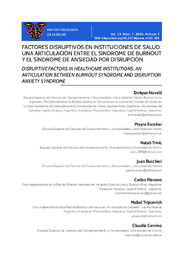Please use this identifier to cite or link to this item:
https://hdl.handle.net/11000/33927Full metadata record
| DC Field | Value | Language |
|---|---|---|
| dc.contributor.author | Novelli, Enrique Mario | - |
| dc.contributor.author | Escobar, Mayra | - |
| dc.contributor.author | Trivic, Natalí | - |
| dc.contributor.author | Buccheri, Juan | - |
| dc.contributor.author | Piovano, Carlos Francisco | - |
| dc.contributor.author | Tripcevich, Mabel | - |
| dc.contributor.author | Cervino, Claudio Osvaldo | - |
| dc.contributor.other | Departamentos de la UMH::Psicología de la Salud | es_ES |
| dc.date.accessioned | 2024-11-19T13:22:36Z | - |
| dc.date.available | 2024-11-19T13:22:36Z | - |
| dc.date.created | 2024 | - |
| dc.identifier.citation | REVISTA PSICOLOGÍA DE LA SALUD Vol. 12. Núm. 1. 2024. | es_ES |
| dc.identifier.issn | 2386-2300 | - |
| dc.identifier.issn | 0214-6118 | - |
| dc.identifier.uri | https://hdl.handle.net/11000/33927 | - |
| dc.description.abstract | Marco Teórico: En el presente estudio se investigan los factores que generan la prevalencia de burnout en el personal de Enfermería. La prevalencia del Síndrome de burnout (SB) es, junto con la insa-tisfacción laboral, un riesgo profesional muy extendido entre el personal que presta sus servicios en las instituciones de salud, donde guardaría una estrecha relación con las condiciones de trabajo. El objetivo es realizar una articulación entre las características de las tres dimensiones del SBcon el Síndrome de Ansiedad por Disrupción (SAD) en una población de enfermeras/os en actividad durante la pandemia COVID-19. Método: Se trató de un estudio observacional, descriptivo y transversal, con participación anónima y voluntaria. Se incluyó 89 enfermeras/os (70 desde Hospital público y 19 desde un Centro privado, Buenos Aires, Argentina). Se relevaron y analizaron datos sobre información sociodemográfica y laboral, factores psicosociales y de salud en el trabajo, y la escala Maslash Bournout Inventory (MBI). Resultados: Se expone y se compara la información recabada desde enfermeras/os de centros de salud público y privado. Los enfermeros de ambos ámbitos de salud manifiestan niveles altos muy si-milares de burnout (~90%), sin diferencias estadísticamente significativas. Conclusiones: La teoría de lo disruptivo aporta recursos valiosos para comprender situaciones complejas reconociendo la relación e influencias recíprocas de: la singularidad y especificidad de los distintos eventos fácticos, la singula-ridad del sujeto que vive la situación, y el comportamiento idiosincrático de un sujeto con un evento específico. | es_ES |
| dc.description.abstract | Theoretical Framework: This study investigates the factors that generate the prevalence of bur-nout in nursing staff. The prevalence of burnout syndrome (BS) is, together with job dissatisfaction, a widespread occupational risk among personnel who provide their services in health institutions, where it would be closely related to working conditions. The objective is to make an articulation between the characteristics of the three dimensions of BS with Disruption Anxiety Syndrome (DAS) in a population of nurses in activity during the COVID-19 pandemic. Method: This was an observational, cross-sectio-nal and descriptive study, with anonymous and voluntary participation. We included 89 nurses (70 from a public hospital and 19 from a private center, Buenos Aires, Argentina). Data on sociodemographic and occupational information, psychosocial and occupational health factors, and the Maslash Bournout Inventory (MBI) scale were collected and analyzed. Results: The information collected from nurses of public and private health centers is exposed and compared. Nurses in both health settings showed very similar high levels of burnout (~90%), with no statistically significant differences. Conclusions: The theory of the disruptive provides valuable resources to understand complex situations recognizing the relationship and reciprocal influences of: the singularity and specificity of the different factual events, the singularity of the subject who lives the situation, and the idiosyncratic behavior of a subject with a specific event. | es_ES |
| dc.format | application/pdf | es_ES |
| dc.format.extent | 17 | es_ES |
| dc.language.iso | spa | es_ES |
| dc.publisher | Universidad Miguel Hernández | es_ES |
| dc.rights | info:eu-repo/semantics/openAccess | es_ES |
| dc.rights.uri | http://creativecommons.org/licenses/by-nc-nd/4.0/ | * |
| dc.subject | Enfermería | es_ES |
| dc.subject | Síndrome de burnout | es_ES |
| dc.subject | Síndrome de Ansiedad por Disrupción | es_ES |
| dc.subject | Factores Disruptivos | es_ES |
| dc.subject | Pandemia COVID-19 | es_ES |
| dc.subject | Nursing | es_ES |
| dc.subject | Burnout syndrome | es_ES |
| dc.subject | Disruption Anxiety Syndrome | es_ES |
| dc.subject | Disruptive Factors | es_ES |
| dc.subject | COVID-19 Pandemic | es_ES |
| dc.subject.other | CDU::1 - Filosofía y psicología::159.9 - Psicología | es_ES |
| dc.title | Factores disruptivos en instituciones de salud: su impacto en trastornos psicofísicos y prevalencia de burnout | es_ES |
| dc.type | info:eu-repo/semantics/article | es_ES |
| dc.relation.publisherversion | https://doi.org/10.21134/pssa.v12i1.102 | es_ES |

View/Open:
administrator,+1868-Texto+del+artículo-9116-1-6-20230821.pdf
496,76 kB
Adobe PDF
Share:
.png)
